Development of 2400–2450 MHz Frequency Band RF Energy Harvesting System for Low-Power Device Operation
Abstract
:1. Introduction
2. Modeling and Simulation
2.1. Receiving Anntenna
2.2. Matching and Rectifier Circuit Design
2.3. Fabrication
3. Results and Discussion
4. Conclusions
Author Contributions
Funding
Institutional Review Board Statement
Informed Consent Statement
Data Availability Statement
Conflicts of Interest
References
- Basu, A.; Basu, A.K.; Ghosh, S.; Bhattacharya, S. Introduction to MEMS Applications in Electronics and Engineering. In MEMS Applications in Electronics and Engineering; AIP Publishing: College Park, MA, USA, 2023; pp. 1–4. [Google Scholar]
- Shi, Y.; Cui, X.; Qi, L.; Zhang, X.; Li, X.; Shen, H. A Novel Energy Harvesting Method for Online Monitoring Sensors in HVdc Overhead Line. IEEE Trans. Ind. Electron. 2023, 70, 2139–2143. [Google Scholar] [CrossRef]
- Piyarathna, I.E.; Lim, Y.Y.; Edla, M.; Thabet, A.M.; Ucgul, M.; Lemckert, C. Enhancing the Bandwidth and Energy Production of Piezoelectric Energy Harvester Using Novel Multimode Bent Branched Beam Design for Human Motion Application. Sensors 2023, 23, 1372. [Google Scholar] [CrossRef]
- Sarang, S.; Stojanović, G.M.; Drieberg, M.; Stankovski, S.; Bingi, K.; Jeoti, V. Machine Learning Prediction Based Adaptive Duty Cycle MAC Protocol for Solar Energy Harvesting Wireless Sensor Networks. IEEE Access 2023, 11, 17536–17554. [Google Scholar] [CrossRef]
- Calautit, K.; Johnstone, C. State-of-the-Art Review of Micro to Small-Scale Wind Energy Harvesting Technologies for Building Integration. Energy Convers. Manag. X 2023, 20, 100457. [Google Scholar] [CrossRef]
- Zhang, M.; Song, R.; Zhang, J.; Zhou, C.; Peng, G.; Tian, H.; Wu, T.; Li, Y. Research on Electromagnetic Vibration Energy Harvester for Cloud-Edge-End Collaborative Architecture in Power Grid. J. Cloud Comput. 2023, 12, 155. [Google Scholar] [CrossRef]
- Li, B.; Chen, H.; Xia, B.; Yao, L. Acoustic Energy Harvesting Based on Topological States of Multi-Resonant Phononic Crystals. Appl. Energy 2023, 341, 121142. [Google Scholar] [CrossRef]
- Liu, X.; Li, M.; Chen, X.; Zhao, Y.; Xiao, L.; Zhang, Y. A Compact RF Energy Harvesting Wireless Sensor Node with an Energy Intensity Adaptive Management Algorithm. Sensors 2023, 23, 8641. [Google Scholar] [CrossRef] [PubMed]
- Alippi, C.; Anastasi, G.; Di Francesco, M.; Roveri, M. Energy Management in Wireless Sensor Networks with Energy-Hungry Sensors. IEEE Instrum. Meas. Mag. 2009, 12, 16–23. [Google Scholar] [CrossRef]
- Todaro, M.T.; Guido, F.; Algieri, L.; Mastronardi, V.M.; Desmaele, D.; Epifani, G.; De Vittorio, M. Biocompatible, Flexible, and Compliant Energy Harvesters Based on Piezoelectric Thin Films. IEEE Trans. Nanotechnol. 2018, 17, 220–230. [Google Scholar] [CrossRef]
- Liao, Y.-T.; Yao, H.; Lingley, A.; Parviz, B.; Otis, B.P. A 3-ΜW CMOS Glucose Sensor for Wireless Contact-Lens Tear Glucose Monitoring. IEEE J. Solid-State Circuits 2012, 47, 335–344. [Google Scholar] [CrossRef]
- Tsui, C.-Y. Energy Harvesting and Power Delivery for Implantable Medical Devices. Found. Trends Electron. Des. Autom. 2013, 7, 179–246. [Google Scholar] [CrossRef]
- Yip, M.; Jin, R.; Nakajima, H.H.; Stankovic, K.M.; Chandrakasan, A.P. A Fully-Implantable Cochlear Implant SoC with Piezoelectric Middle-Ear Sensor and Arbitrary Waveform Neural Stimulation. IEEE J. Solid-State Circuits 2015, 50, 214–229. [Google Scholar] [CrossRef] [PubMed]
- Roy, S.; Tiang, J.-J.; Bin Roslee, M.; Ahmed, M.T.; Kouzani, A.Z.; Mahmud, M.A.P. Design of a Highly Efficient Wideband Multi-Frequency Ambient RF Energy Harvester. Sensors 2022, 22, 424. [Google Scholar] [CrossRef] [PubMed]
- Zada, M.; Iman, U.R.; Basir, A.; Yoo, H. Battery-Free Digitally Embroidered Smart Textile Energy Harvester for Wearable Healthcare IoTs. IEEE Trans. Ind. Electron. 2023, 71, 9865–9874. [Google Scholar] [CrossRef]
- Khan, N.U.; Khan, F.U. RF Energy Harvesting for Portable Biomedical Devices. In Proceedings of the 2019 22nd International Multitopic Conference (INMIC), Islamabad, Pakistan, 29–30 November 2019; pp. 1–6. [Google Scholar]
- Muhammad, S.; Smida, A.; Waly, M.I.; Mallat, N.K.; Iqbal, A.; Reza Khan, S.; Alibakhshikenari, M. Design of Wideband Circular-Slot Antenna for Harvesting RF Energy. Int. J. Antennas Propag. 2022, 2022, 5964753. [Google Scholar] [CrossRef]
- Thompson, M.; Fidler, J.K. Determination of the Impedance Matching Domain of Impedance Matching Networks. IEEE Trans. Circuits Syst. I Regul. Pap. 2004, 51, 2098–2106. [Google Scholar] [CrossRef]
- Alibakhshikenari, M.; Virdee, B.S.; Shukla, P.; See, C.H.; Abd-Alhameed, R.A.; Falcone, F.; Limiti, E. Improved Adaptive Impedance Matching for RF Front-End Systems of Wireless Transceivers. Sci. Rep. 2020, 10, 14065. [Google Scholar] [CrossRef] [PubMed]
- Cansiz, M.; Altinel, D.; Kurt, G.K. Efficiency in RF Energy Harvesting Systems: A Comprehensive Review. Energy 2019, 174, 292–309. [Google Scholar] [CrossRef]
- Khan, N.U.; Khan, F.U.; Farina, M.; Merla, A. RF Energy Harvesters for Wireless Sensors, State of the Art, Future Prospects and Challenges: A Review. Phys. Eng. Sci. Med. 2024, 2662–4737. [Google Scholar] [CrossRef]
- Nikkhah, N.; Keshavarz, R.; Abolhasan, M.; Lipman, J.; Shariati, N. Efficient Dual-Band Single-Port Rectifier for RF Energy Harvesting at FM and GSM Bands. In Proceedings of the 2022 Wireless Power Week (WPW), Bordeaux, France, 5–8 July 2022; pp. 141–145. [Google Scholar]
- Muhammad, S.; Tiang, J.J.; Wong, S.K.; Smida, A.; Waly, M.I.; Iqbal, A. Efficient Quad-Band RF Energy Harvesting Rectifier for Wireless Power Communications. AEU Int. J. Electron. Commun. 2021, 139, 153927. [Google Scholar] [CrossRef]
- Chun, A.C.C.; Ramiah, H.; Mekhilef, S. Wide Power Dynamic Range CMOS RF-DC Rectifier for RF Energy Harvesting System: A Review. IEEE Access 2022, 10, 23948–23963. [Google Scholar] [CrossRef]
- Kadir, E.A.; Hu, A.P.; Biglari-Abhari, M.; Aw, K.C. Indoor WiFi Energy Harvester with Multiple Antenna for Low-Power Wireless Applications. In Proceedings of the 2014 IEEE 23rd International Symposium on Industrial Electronics (ISIE), Istanbul, Turkey, 1–4 June 2014; pp. 526–530. [Google Scholar]
- DeLong, B.J.; Kiourti, A.; Volakis, J.L. A Radiating Near-Field Patch Rectenna for Wireless Power Transfer to Medical Implants at 2.4 GHz. IEEE J. Electromagn. RF Microw. Med. Biol. 2018, 2, 64–69. [Google Scholar] [CrossRef]
- Kim, S.; Bito, J.; Jeong, S.; Georgiadis, A.; Tentzeris, M.M. A Flexible Hybrid Printed RF Energy Harvester Utilizing Catalyst-Based Copper Printing Technologies for Far-Field RF Energy Harvesting Applications. In Proceedings of the 2015 IEEE MTT-S International Microwave Symposium, Phoenix, AZ, USA, 17–22 May 2015; pp. 1–4. [Google Scholar]
- Liu, X.; Li, M.; Chen, X.; Zhao, Y.; Xiao, L.; Zhang, Y. A Compact Stacked RF Energy Harvester with Multi-Condition Adaptive Energy Management Circuits. Micromachines 2023, 14, 1967. [Google Scholar] [CrossRef]
- Li, P.; Long, Z.; Yang, Z. RF Energy Harvesting for Batteryless and Maintenance-Free Condition Monitoring of Railway Tracks. IEEE Internet Things J. 2021, 8, 3512–3523. [Google Scholar] [CrossRef]
- Loubet, G.; Takacs, A.; Dragomirescu, D. Implementation of a Battery-Free Wireless Sensor for Cyber-Physical Systems Dedicated to Structural Health Monitoring Applications. IEEE Access 2019, 7, 24679–24690. [Google Scholar] [CrossRef]
- Divakaran, S.K.; Das Krishna, D. Nasimuddin RF Energy Harvesting Systems: An Overview and Design Issues. Int. J. RF Microw. Comput. Eng. 2019, 29, e21633. [Google Scholar] [CrossRef]
- Muhammad, S.; Tiang, J.J.; Wong, S.K.; Smida, A.; Ghayoula, R.; Iqbal, A. A Dual-Band Ambient Energy Harvesting Rectenna Design for Wireless Power Communications. IEEE Access 2021, 9, 99944–99953. [Google Scholar] [CrossRef]
- Christina, G. A Review on Microstrip Patch Antenna Performance Improvement Techniques on Various Applications. J. Trends Comput. Sci. Smart Technol. 2021, 3, 175–189. [Google Scholar] [CrossRef]
- ur Rehman, M.; Ahmad, W.; Khan, W.T. Highly Efficient Dual Band 2.45/5.85 GHz Rectifier for RF Energy Harvesting Applications in ISM Band. In Proceedings of the 2017 IEEE Asia Pacific Microwave Conference (APMC), Kuala Lumpur, Malaysia, 13–16 November 2017; pp. 150–153. [Google Scholar]
- Park, S.; Yang, J.; Rivas-Davila, J. A Hybrid Cockcroft–Walton/Dickson Multiplier for High Voltage Generation. IEEE Trans. Power Electron. 2020, 35, 2714–2723. [Google Scholar] [CrossRef]
- Chong, G.; Ramiah, H.; Yin, J.; Rajendran, J.; Wong, W.R.; Mak, P.-I.; Martins, R.P. Ambient RF Energy Harvesting System: A Review on Integrated Circuit Design. Analog Integr. Circuits Signal Process. 2018, 97, 515–531. [Google Scholar] [CrossRef]
- Chen, D.; Li, R.; Xu, J.; Li, D.; Fei, C.; Yang, Y. Recent Progress and Development of Radio Frequency Energy Harvesting Devices and Circuits. Nano Energy 2023, 117, 108845. [Google Scholar] [CrossRef]
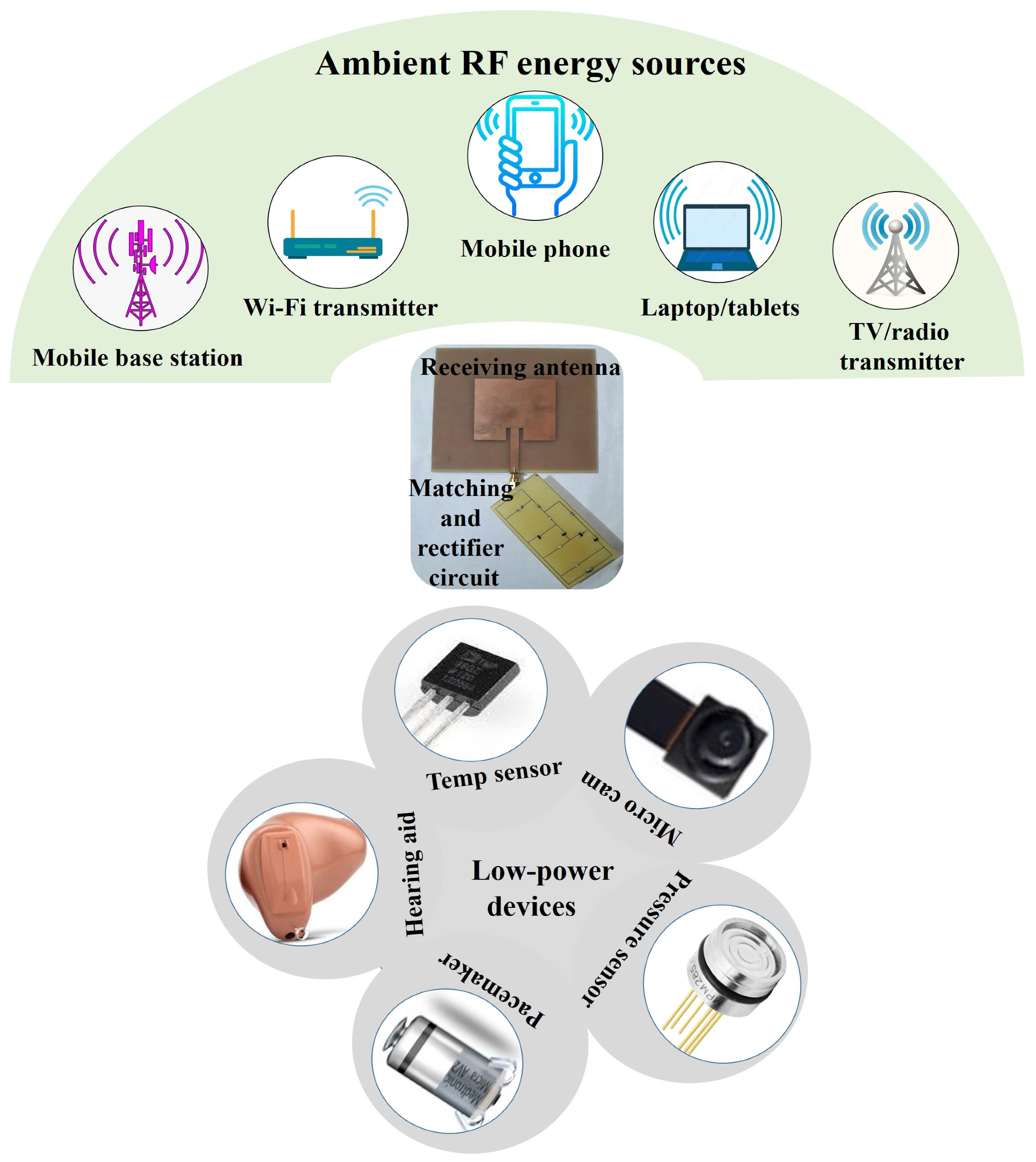
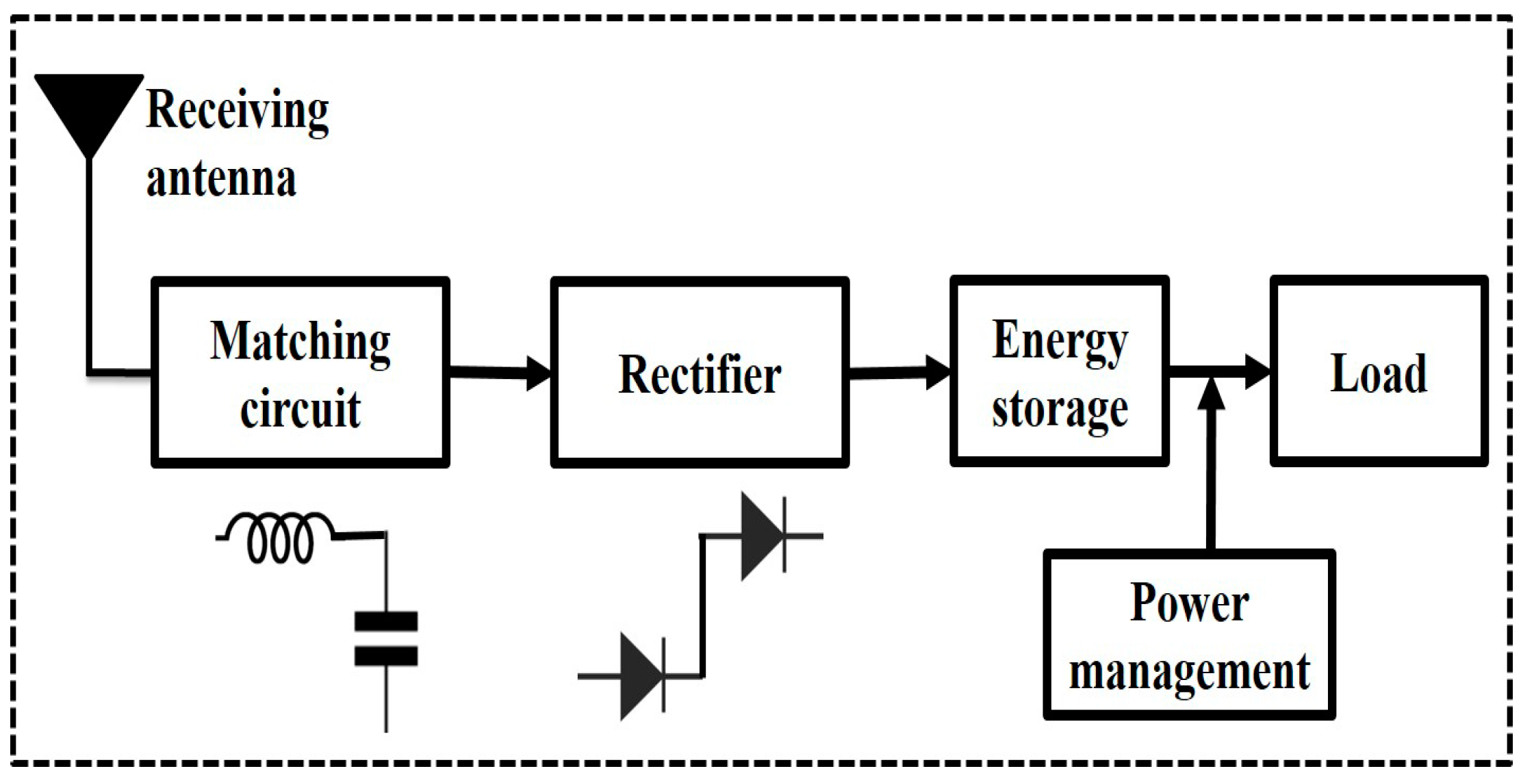
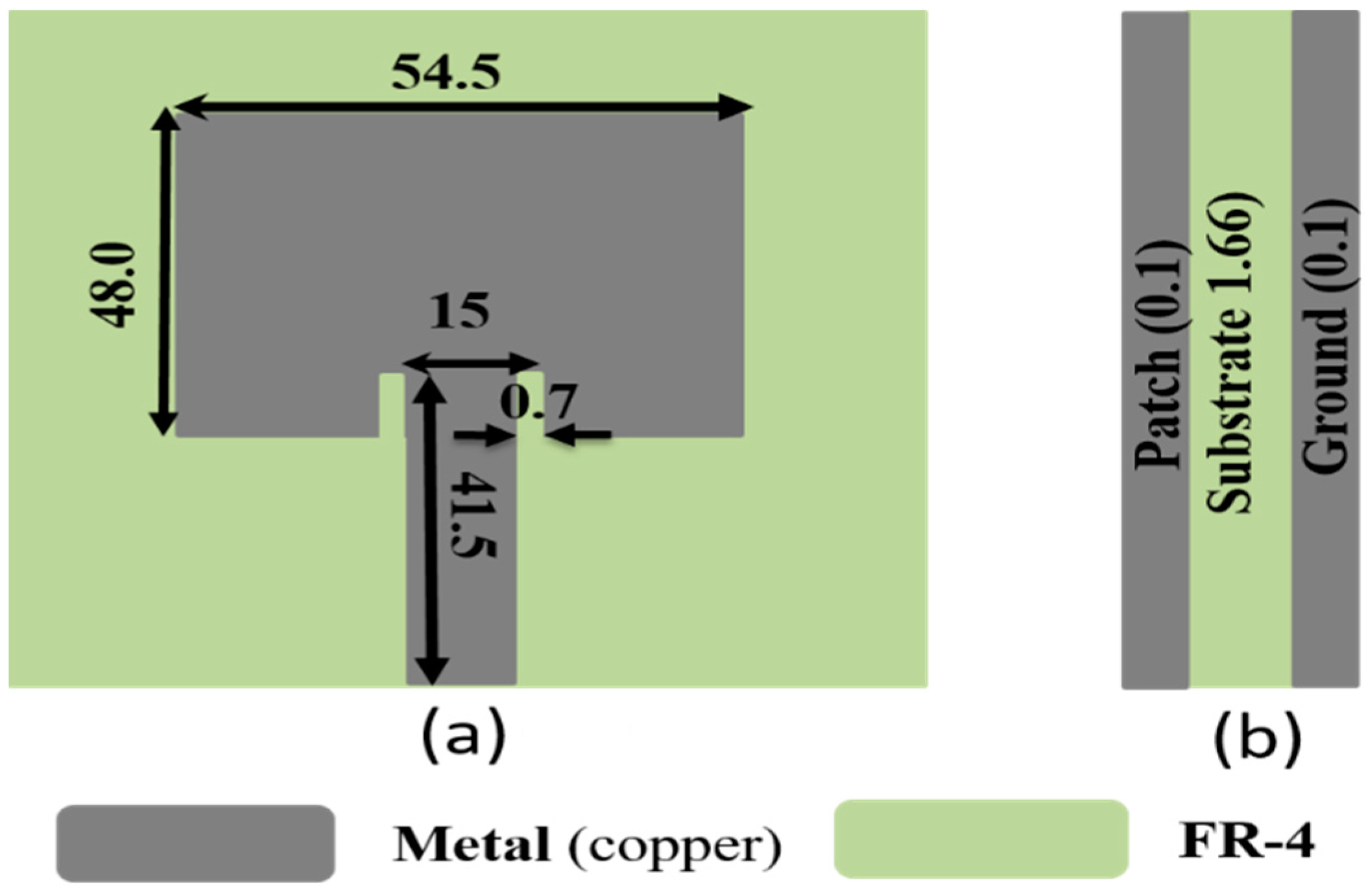
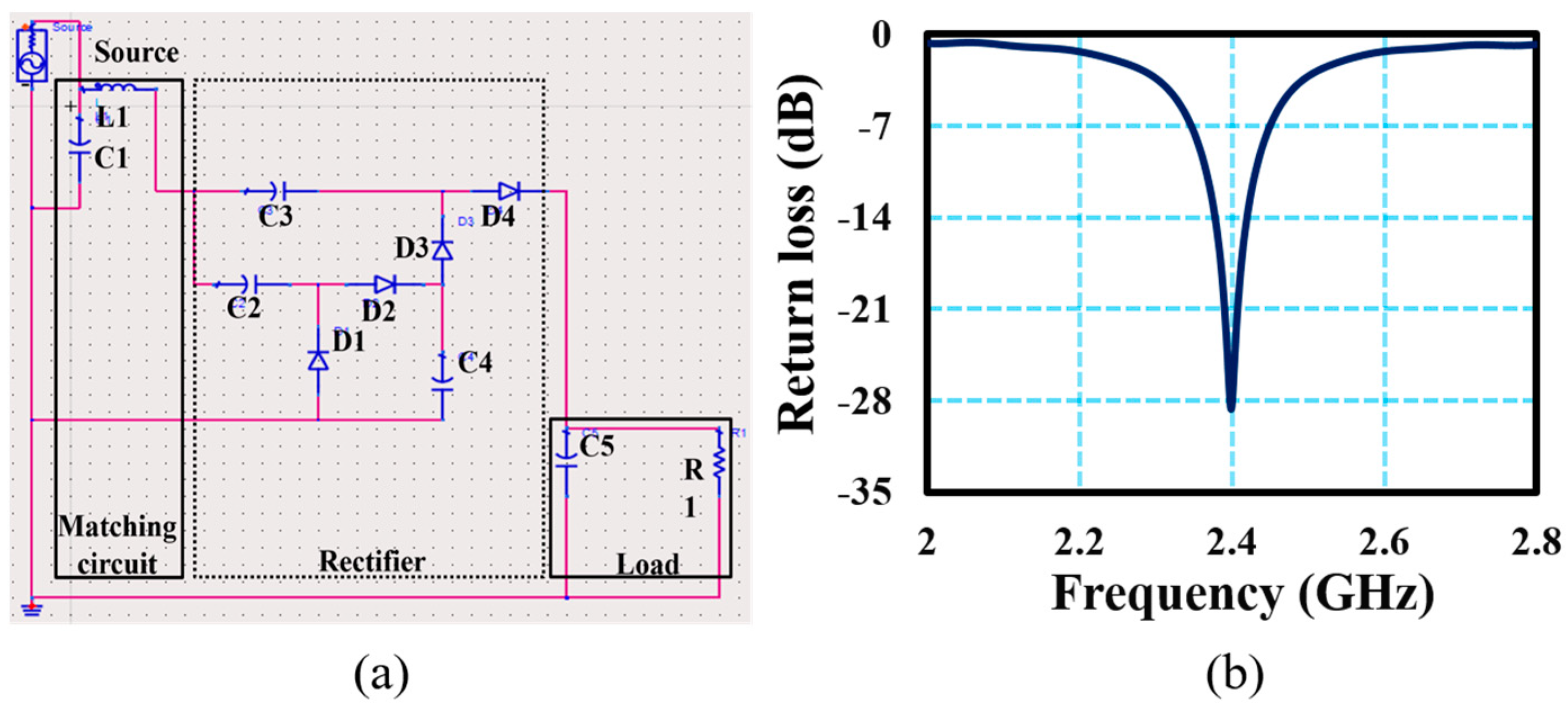
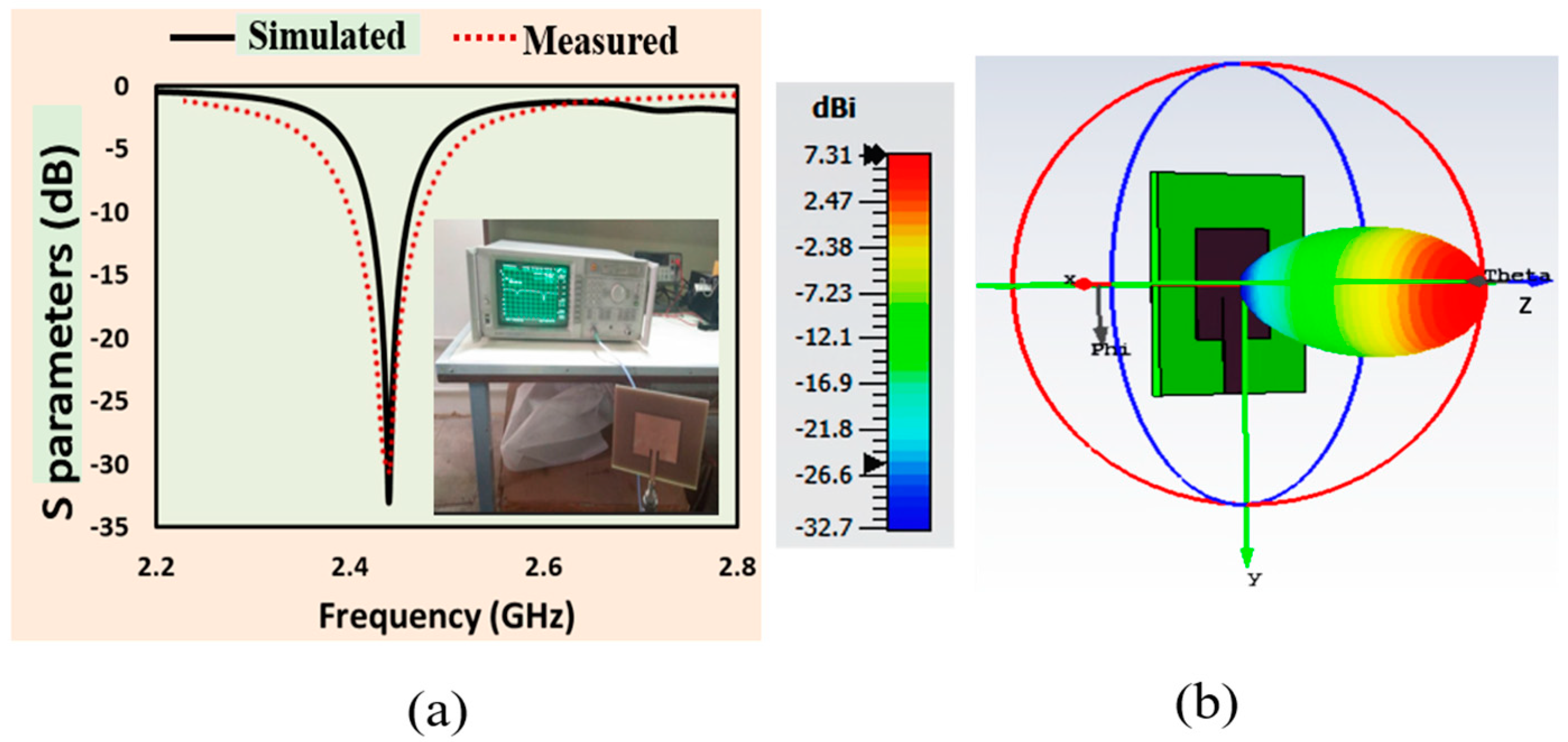
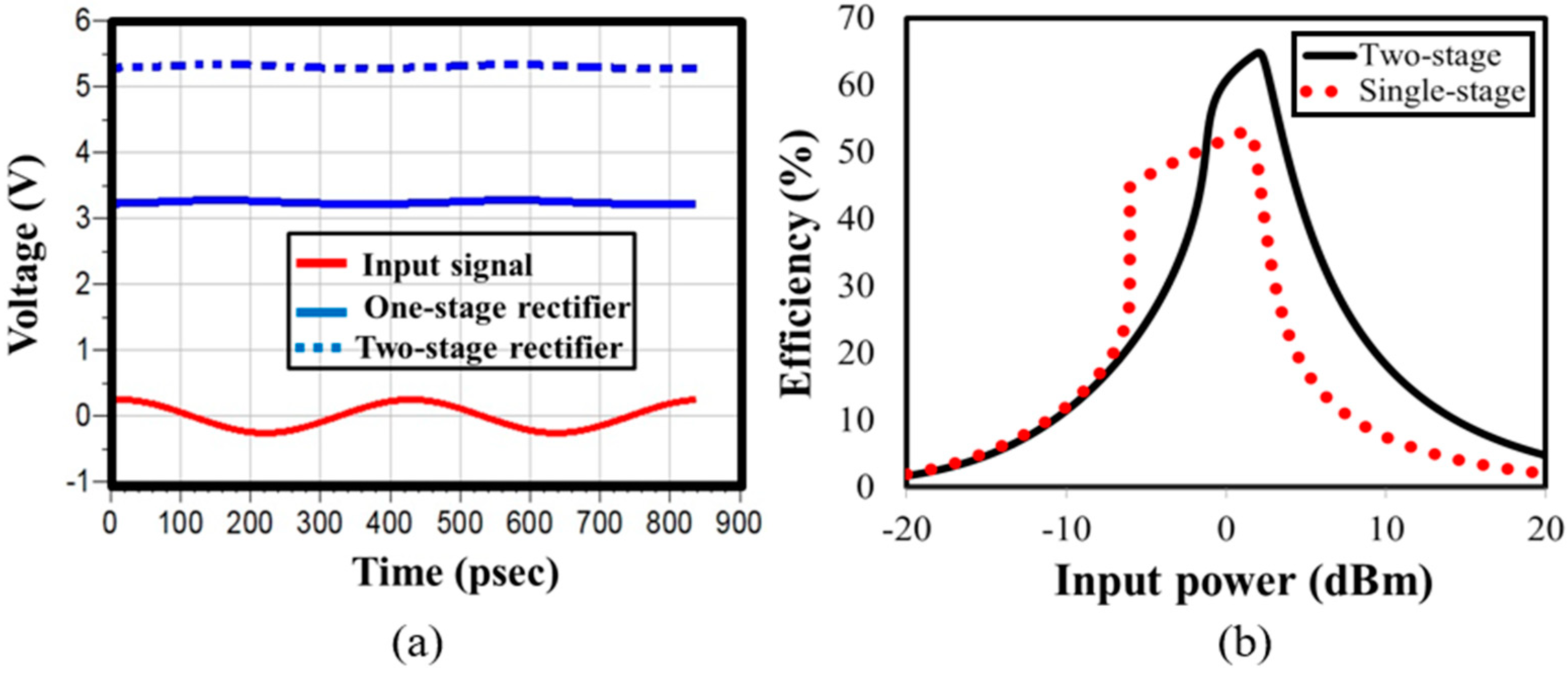
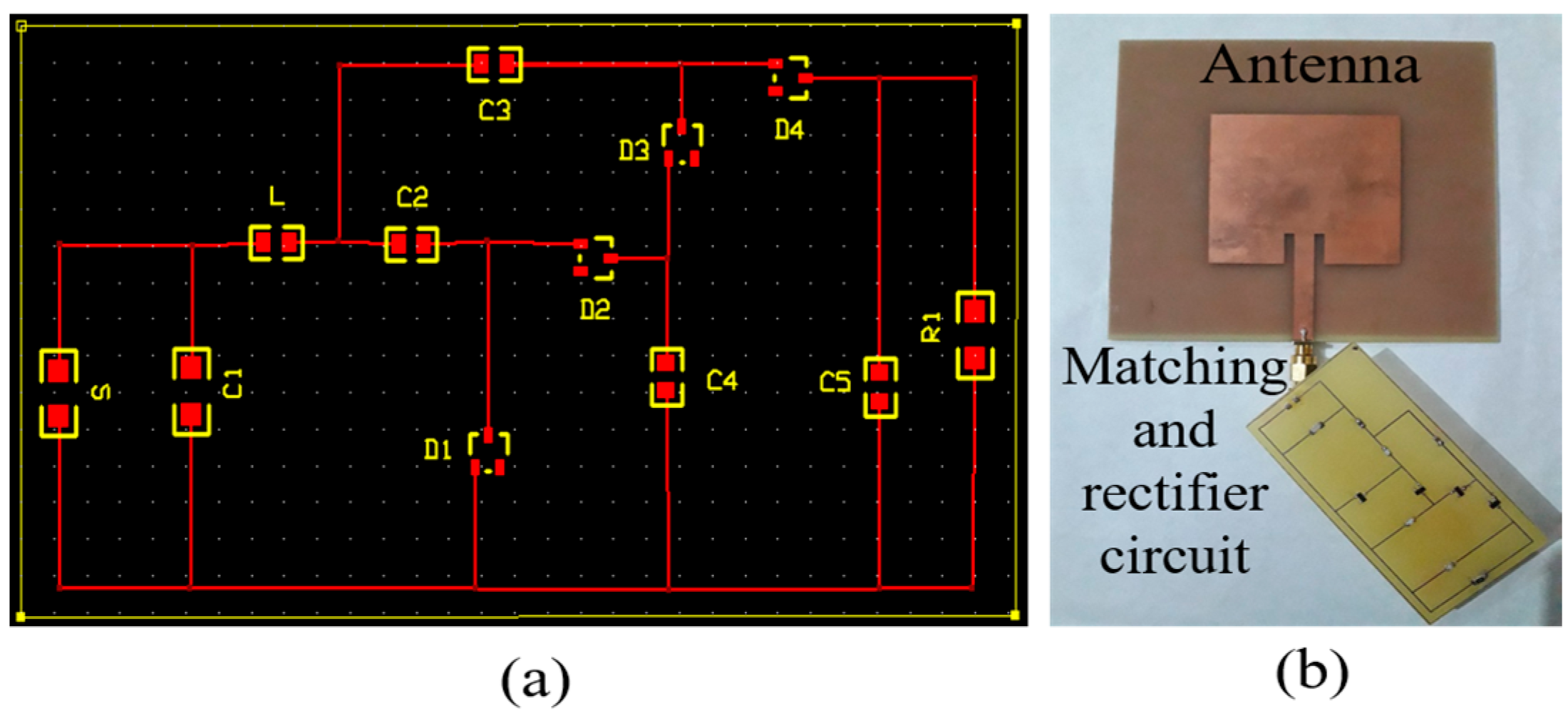
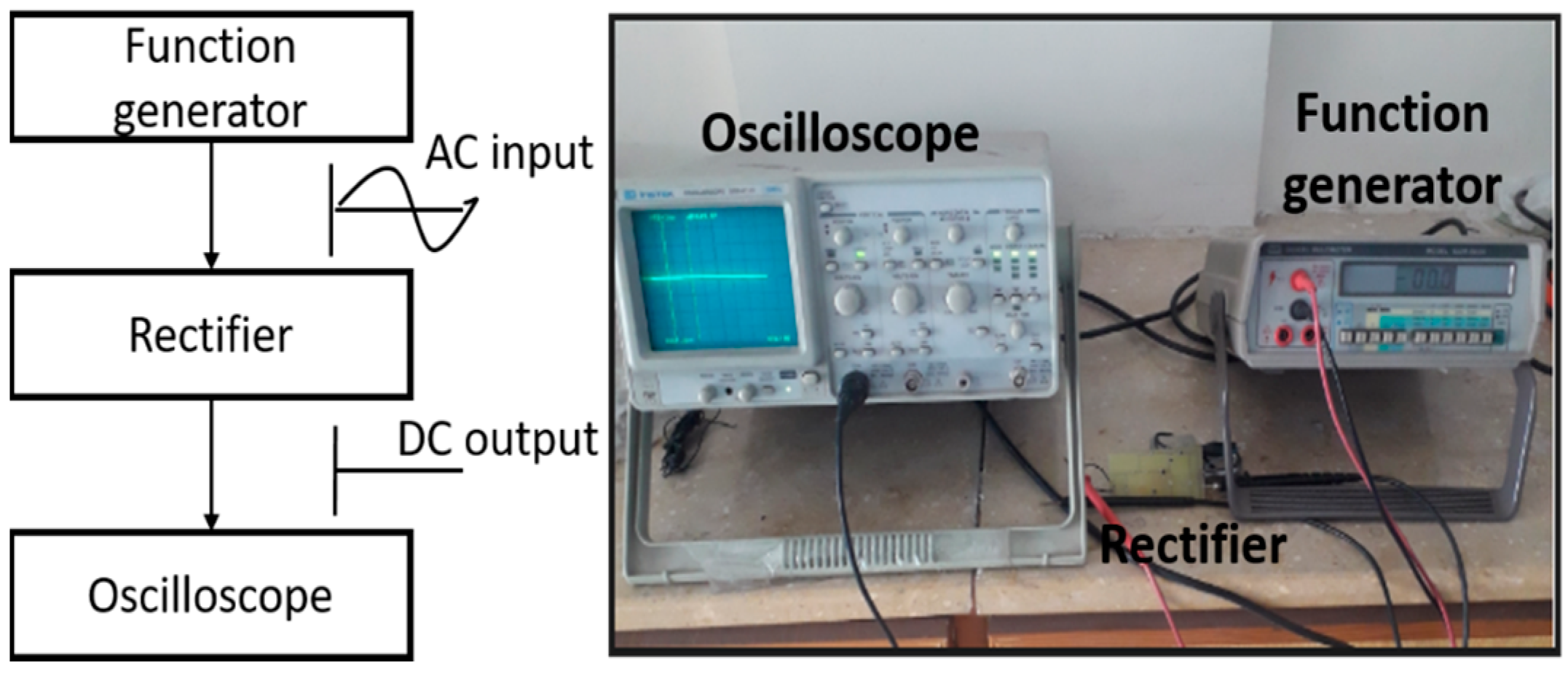


| Low-Power Device | Temperature Sensor | Smoke Sensor | Glucose Sensor | Pacemaker | Cochlear Implant | Smartwatch |
|---|---|---|---|---|---|---|
| Reference | [9] | [10] | [11] | [12] | [13] | [14] |
| Voltage required (V) | 2–3.3 | 3.3–12 | 3.3–5.5 | 2–5.5 | 1.5–5.5 | 1.5–3.3 |
| Power required (µW) | 400 | 1000 | 3 | 1–10 | 100–10,000 | 1 |
| Power level | Low | Low | Extremely low | Extremely low | Low | Extremely low |
| Parameter | Value or Range |
|---|---|
| Minimum AC voltage rectified | 50–180 mV |
| Maximum voltage rectified | 1500–1300 mV |
| Input AC voltage levels | 50–1500 mV |
| Load resistances | 1.5–126,000 kΩ |
| Optimum load | 470,000 Ω |
| Maximum T factor | 4.10 |
| References | [25] | [26] | [27] | [8] | [28] | [29] | [30] | This Work |
|---|---|---|---|---|---|---|---|---|
| Antenna size/ Rectifier size (mm × mm) | 28.5 × 28/NA | 27.5 × 25.90/14 × 27.5 | 89 × 89/55 × 20 | 53 × 43.4/13.15 × 8.23 | 53 × 43.5/22.07 × 26.2 | NA | 110 × 60/70 × 50 | 54.5 × 48/76.2 × 38.1 |
| Resonance frequency (MHz) | 2400 | 2400 | 915 | 2437 | 2452 | 915 | 915 | 2450 |
| Matching network | Open-circuit stub | Transmission line stubs | N/A | Transmission line stubs | Transmission line stubs | LC-based | Short circuit stub | LC-based |
| Rectifier stages | Seven | Two | Five | Multiple | Single | Three | Single | Two |
| Substrate | FR-4 | Rogers TMM10 | Polymer | PTFE | PTFE + FR-4 | CMOS | FR-4 | FR-4 |
| Output voltage (V) | 2 | 2.6 | 2.9 | 4.8 | 2.8 | 4 | 2.3 | 5.2 |
| PCE (%) @ input power (dBm) | 18.6 @ −50 | 47.7 @ 11 | 20 @ 0 | 52.5 @ 7 | 33.8 @ 5 | 25 @ 1 | 25 @ 0 | 64 @ 0 |
Disclaimer/Publisher’s Note: The statements, opinions and data contained in all publications are solely those of the individual author(s) and contributor(s) and not of MDPI and/or the editor(s). MDPI and/or the editor(s) disclaim responsibility for any injury to people or property resulting from any ideas, methods, instructions or products referred to in the content. |
© 2024 by the authors. Licensee MDPI, Basel, Switzerland. This article is an open access article distributed under the terms and conditions of the Creative Commons Attribution (CC BY) license (https://creativecommons.org/licenses/by/4.0/).
Share and Cite
Khan, N.U.; Ullah, S.; Khan, F.U.; Merla, A. Development of 2400–2450 MHz Frequency Band RF Energy Harvesting System for Low-Power Device Operation. Sensors 2024, 24, 2986. https://doi.org/10.3390/s24102986
Khan NU, Ullah S, Khan FU, Merla A. Development of 2400–2450 MHz Frequency Band RF Energy Harvesting System for Low-Power Device Operation. Sensors. 2024; 24(10):2986. https://doi.org/10.3390/s24102986
Chicago/Turabian StyleKhan, Nasir Ullah, Sana Ullah, Farid Ullah Khan, and Arcangelo Merla. 2024. "Development of 2400–2450 MHz Frequency Band RF Energy Harvesting System for Low-Power Device Operation" Sensors 24, no. 10: 2986. https://doi.org/10.3390/s24102986





